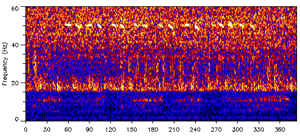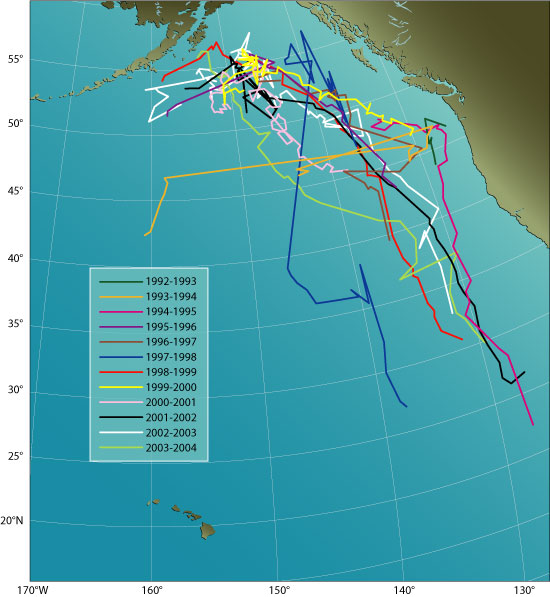For 24 years, researchers have been tracking the migration of a whale which has a unique sonic signature – so unique that it appears to have never found a mate. “The 52-Hertz Whale is a unique whale that calls at a characteristic frequency of 52 Hz, a much higher frequency than the vocalizations of most whales. It appears to be the only individual with this call, and it has been described as the world’s loneliest whale.
At 52 Hertz, it is just higher than the lowest note on a tuba. The call patterns resemble neither blue nor fin whales – they are shorter and more frequent, besides being at a much higher frequency. Blue whales usually vocalize at 15–20 Hz, fin whales at 20. The 52-Hertz signals are highly variable in their pattern of repetition, duration, and sequence, although they are easily identifiable due to their frequency and characteristic clustering.
The track of the 52-Hertz whale is unrelated to the presence or movement of other whale species. Its movements have been somewhat similar to that of blue whales, but its timing has been more like that of fin whales. It is detected in the Pacific Ocean every year, beginning in August–December, and moves out of range of the hydrophones in January–February. It travels as far north as the Aleutian and Kodiak Islands and as far south as the California coast, swimming between 30 and 70 km each day. Its (recorded) distance traveled per season has ranged from a low of 708 km to a high of 11,062 km in 2002–2003. Whatever biological cause underlies its unusually high voice does not seem to be detrimental to its survival. The fact that the whale has survived and apparently matured indicates that it is probably healthy. Still, it is the only one of its kind detected anywhere, and there is only one such source per season. Because of this, the animal has been called the loneliest whale in the world” (source).
“William Watkins of the Woods Hole Oceanographic Institution, who invented the first underwater recording system, first heard 52-Hertz’s unique high-pitched song back in 1989 when he was studying the mating calls of male whales, which are far more vocal than the females.” On average, these tones had a center frequency of 51.75 Hz and lasted 5-7 sec. These tones are usually produced in groups of 2-6 and were recorded in the NE Pacific. (Click here for a recording of 52-Hertz.) “The US Navy’s sophisticated billion-dollar hydrophone system, designed to track Soviet nuclear submarines during the Cold War, recorded his migratory patterns in great detail each year, cruising from central California to the Aleutian Islands in the north Pacific. He always travels solo, ‘unrelated to the presence or movement of other whale species,’ according to the original report in Deep Sea Journal. However, the defense department only releases data days after 52-Hertz has moved on, too late for scientists to dispatch vessels to meet him in person. Unsurprisingly, the cash-strapped US Navy has little interest in pursuing a solitary, love-sick whale” (source).
Article by Bill Norrington




